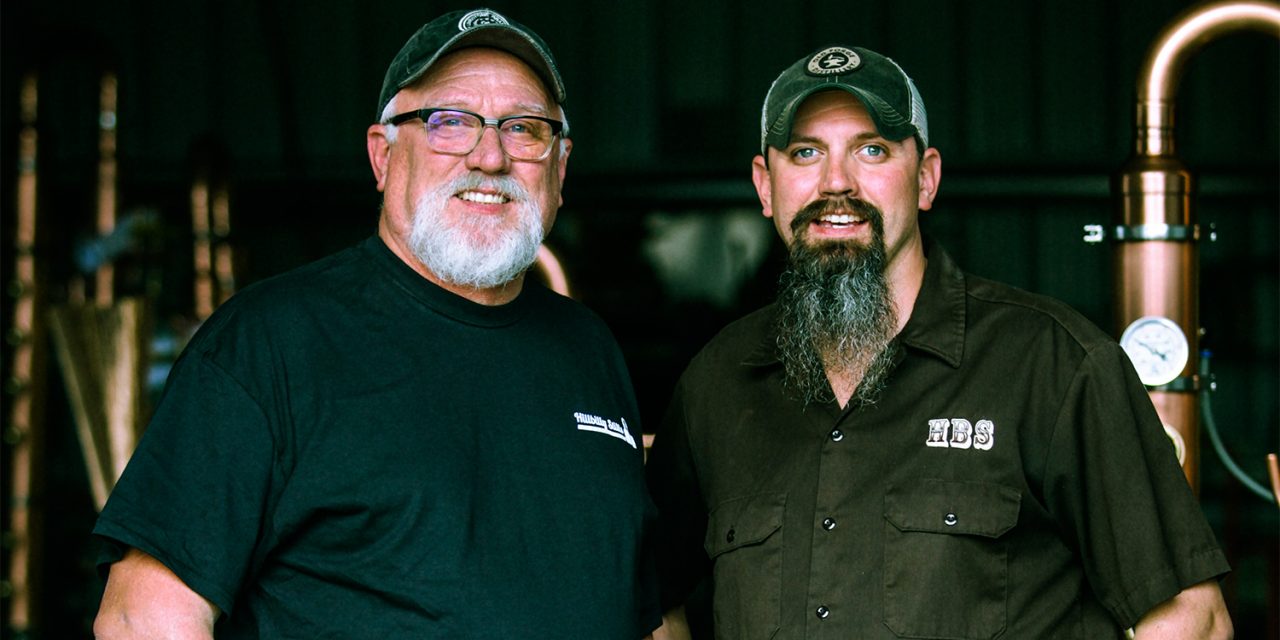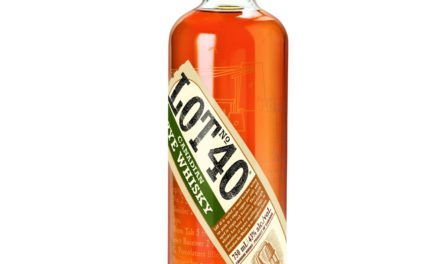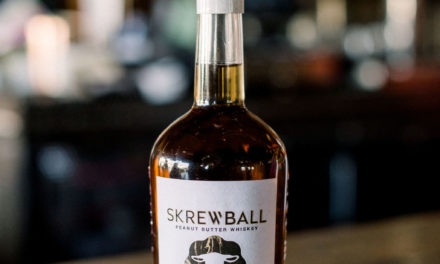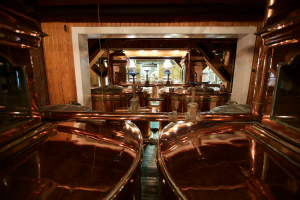
To ensure the quality and consistency of its bourbon, Makers Mark employs three identical stills.
Every aspect of early American colonial life was impacted by some kind of distillation. Whether derived from rum, rye or apples, fermented liquor was a major part of daily life; it even served as currency. Abraham Lincoln’s father, who worked for a Kentucky distiller, bought a farm for two barrels of whiskey.
Bourbon whiskey, which wasn’t officially called “bourbon” until 1840, became the king of all American ferments due to the proliferation of corn. Native to the Americas, corn was prevalent from New York to Pennsylvania to Kentucky. A horse could carry four bushels of raw corn but could haul the equivalent of 24 when it was distilled into whiskey. Math was clearly in favor of hooch.
Even the Father of our country, George Washington, was in the distillation business: he built one of the larger distilleries at Mount Vernon in 1797 to produce whiskey from corn and rye. Thomas Jefferson is famous for facilitating bourbon’s production by repealing the unpopular Whiskey Tax and completing the Louisiana Purchase, which made the Mississippi River a main delivery vessel for whiskey to the port of New Orleans.
Bourbon, though named for a prestigious French family, is so undeniably American that, in 1964, Congress declared it “a distinctive product of the U.S.A.” Says Rob Samuels of Maker’s Mark, “There’s no other spirit more tried-and-true American as bourbon. It’s America’s native spirit.”
Bourbon: The Straight Skinny
Bourbon is defined as a whiskey made from a mash (also called a “mash bill”) containing at least 51% corn, distilled out at a maximum of 160° proof (80% alcohol) and aged at no more than 125° proof (62.5% alcohol) in new charred oak barrels. Bourbon labeled as “straight” must age for a minimum of two years in oak and, if aged less than four years, this must be stated on the bottle. No coloring or flavoring may be added to any “straight” whiskey. Bourbon is bottled at 80° proof (40% alcohol) or higher. If the label says “bottled in bond,” it must be 100° proof, while “barrel proof” means it’s more than 100°.
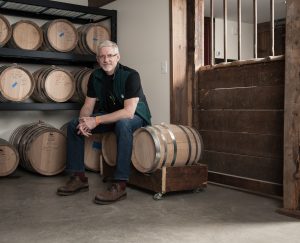
Mad River Distillers chief distiller and co-founder Brett Little
Most bourbons are made from a mash bill containing varying percentages of corn and rye, while some contain wheat or barley for smoothness. The use of “sour mash” is credited to James C. Crow, where each new fermentation is aided by some of the previously spent — or used — mash (also called spent beer or feed mash, because it’s sometimes fed to animals). Acid in the mash helps control bacteria that could otherwise spoil the whiskey.
Allegedly, a Baptist minister named Elijah Craig was the first to age bourbon in charred casks, at a distillery he established in Kentucky. But another early distiller, Jacob Spears, is credited with first putting the word “bourbon” on his whiskey bottles.
Barrel choices, aging time, location and rotation schedule in the warehouse (also called “rickhouse”) — all contribute to product differentiation. This explains why a distillery like Buffalo Trace in Frankfort, Ky., puts out so many brands using the same still.
Still The Ones: The Major Suppliers
You can’t make bourbon – or any other distillate – without a still. Mad River Distillers, a craft producer in Burlington, Vt., sought a still with proven ability to preserve the flavors of the ingredients. For them, only Mueller would do. This German manufacturer has a sterling reputation for making some of the finest pot stills in existence. Frank Dieter, based in Okanagan, B.C., where he established the first craft distillery in the region, is the company’s North American rep. A distiller himself, he knows his stuff. He says the workmanship sets Mueller stills apart, calling them “works of art.”
Says Mad River chief distiller and co-founder Brett Little, “All the best fruit stills are German and Mueller has unique patented features for controlling cooling elements. This is critical for fruit brandy, which was our overarching ambition.”
Mad River began producing apple brandy, called Malvados, and soon tried rum and bourbon. Thinking most bourbons on the market had too much rye, Little chose the softness of wheat, which has less burn. Plus, pot stills (as opposed to column stills) preserve the essence of the grain. He says, “There’s a reason the Scotch use pot stills for their whisky.”
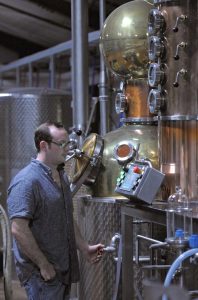
Litchfield Distillers uses its Mueller still to produce bourbon, including one infused with coffee.
Little says the Mueller still transmits nuances. “You can taste all the components, including the grassiness of the corn, the earthiness of the wheat and the brightness of the barley. We use a ‘low and slow’ approach — we take our time, pay attention to temperatures and take no shortcuts. All our barrels are made with staves aged a minimum of two years, and we look to like-minded craftspeople in the trade to source all of our ingredients. You have to walk the walk.”
Another happy Mueller customer is Litchfield Distillers in Litchfield, Conn. Co-founder Jack Baker (with his brother, David) reports, “We purchased [the Mueller] based on design, quality, craftsmanship, complete package and reputation. The still has performed flawlessly and as intended. Frank Dieter has been responsive and helpful throughout our startup.” The still has been operational for two years and the company is producing bourbon, including a coffee-infused one.
Bavarian Breweries & Distilleries is a supplier of German distillers with a strong reputation in domestic and international markets. Based in Culver City, Calif., brewer, distiller and equipment expert Lewis Harsanyi has lived in California for 40 years and has been the sole distributor for Arnold Holstein stills since 2001. Holstein has more than 6,000 stills installed worldwide. “They last forever, with a little exaggeration,” says Harsanyi.
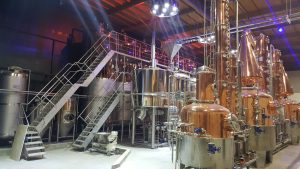
Bavarian Breweries & Distilleries is a supplier of German equipment, including Arnold Holstein stills, for production, for distiller-students, and for those looking for distilling/brewing equipment.
The stills are made in Germany and the tanks are manufactured in Hungary. Originally involved with brewing equipment, Harsanyi explains that in the late 1990s, the brewing business was in crisis and he decided to “stand on more than one leg” by offering distilling systems as well. He’s glad he did. His showcase, Los Angeles Distillery, which cost more than $2 million to outfit, is the largest and most efficient installation in North America; besides production, it serves a workshop setup for would-be distillers to learn the basics. He says the secret to good spirit products encompasses the entire process, from what you choose as your distilling system, the mash bill, how you ferment the mash, how you distil it and the barrels you choose for aging. Every choice impacts the outcome.
The most rewarding part of his job? “When a client fires up the still for the first time and we can taste the purity of the alcohol coming out.”
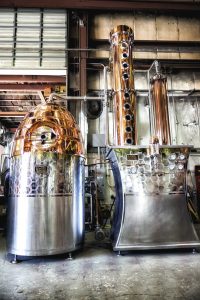
Vendome Copper and Brass Works has been owned by the same family for four generations.
Be Still: American Makers
Domestically, for the big boys whose products dominate the store shelves, there’s one source for their institutional-sized stills and that is Vendome, out of Louisville, Ky. In the same family for four generations, Vendome prides itself on master craftsmen who know how to make beautiful, seamless welds. Says owner Mike Sherman, “My great grandfather started this company in 1904, when there was a lot of still-making going on. We’ve become the largest spirits fabricator in the United States.”
From the start, Vendome made stills for Jim Beam, Jack Daniels, Wild Turkey and Four Roses; the relationships go way back. Today, they handle about 50 to 60 orders per year and each takes eight to 10 months to complete. Most orders are for stills bigger than 100 gallons in size, with 500s and 750s the most popular.
“We did an office lunch at Wild Turkey with my dad, uncle and cousins — three generations of my family have worked with them! I remember walking around the factory as a kid with my Dad and thinking, ‘Wow, this is some operation!’ But then in 2008, the company built a brand new plant with an enormous copper mirror still. It was a project so huge, it took 20 weeks just to source all the copper. We took a year-and-a-half to fabricate all the equipment, most of which had to be done onsite, as it was too large to ship.” (That said, Jack Daniels holds the distinction of having the most Vendome stills under one roof: six, all copper columns.)
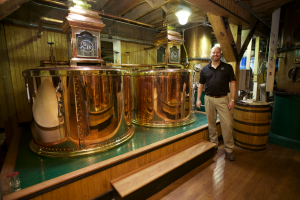
Makers Mark master distiller Greg Davis carries on tradition, producing small batches of premium bourbon using techniques and equipment that reflect the company’s storied history.
Maker’s Mark COO Samuels attests to the longstanding relationship between the two companies. “Vendome has made our stills here at Maker’s Mark since my grandparents started this family business. To ensure the quality and consistency of our handmade bourbon making process, all three stills are exact replicas of one another. Each one is made of solid copper, standing approximately 45-feet tall and 3-feet in diameter.”
Vendome imports most of its copper from Germany these days. It’s the only place that sources sheets in widths of 48-, 68- and 72-inches (the largest U.S. mills can only produce 36-inch sheets).
According to Sherman, the secret is TIG-welding copper, a highly specialized skill that takes years of experience to master. Most shops weld stainless, carbon, steel and aluminum, but not copper. “It’s something you have to do every day, but most welders don’t have much experience with it,” says Sherman. “We hire welders who are good workers and hope they turn into copper welders.”
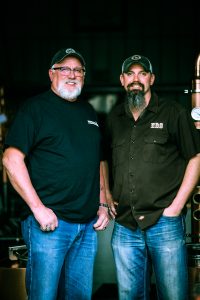
Mike and Matt Haney built Hillbilly Stills from a garage-based hobby to a successful business by focusing on function and craftsmanship.
The other major domestic supplier is Hillbilly Stills, which is owned by Haney Enterprises LLC in Barlow, Ky. (HBS Copper is the commercial equipment division of Hillbilly Stills). Matt Haney explains that his father, who had previously worked at a paper mill for 32 years, needed a hobby when his mother became ill in 2007. He began making moonshine and ordered what Matt calls some “crappy stills.”
Says Matt, “[Dad] decided he could do better, so he did research on online forums and worked with another gentleman via Skype to build the first flute. He knew nothing about how to build a website, but again, he did all of his own research and built his first website along with all the marketing to go with it. Both of us had backgrounds working with metal, so I was able to quit my job at the fiberglass plant and go to work with him.”
Since 2011, they’ve been making stills for customers who make everything from moonshine to Aquavit and Absinthe. It went from a hobby to a commercial operation that now employs eight people. Matt figures they’ve made somewhere between 8,000 and 10,000 stills. Pretty much everything is custom, he continues, adding, “People want efficiency and durability. Time is money. The one thing we strive for is ease of operation. The still has to heat up quickly, and it has to last.”
Bourbon History Museum
If this story has whetted your appetite for more, consider traveling the Bourbon Trail in Kentucky, which was visited by more than 1 million people in 2016. If you make a pilgrimage, be sure to pay homage to the roots of whiskey at the Oscar Getz Museum of Whiskey History in Bardstown, the “Bourbon Capital of the World,” where an annual Bourbon Festival takes place each September.
To close, I’ll leave you with this quote from Mark Twain: “Too much of anything is bad, but too much of good whiskey is barely enough.”
Get drinking!
(To learn more, check out American Bourbon Legends)

